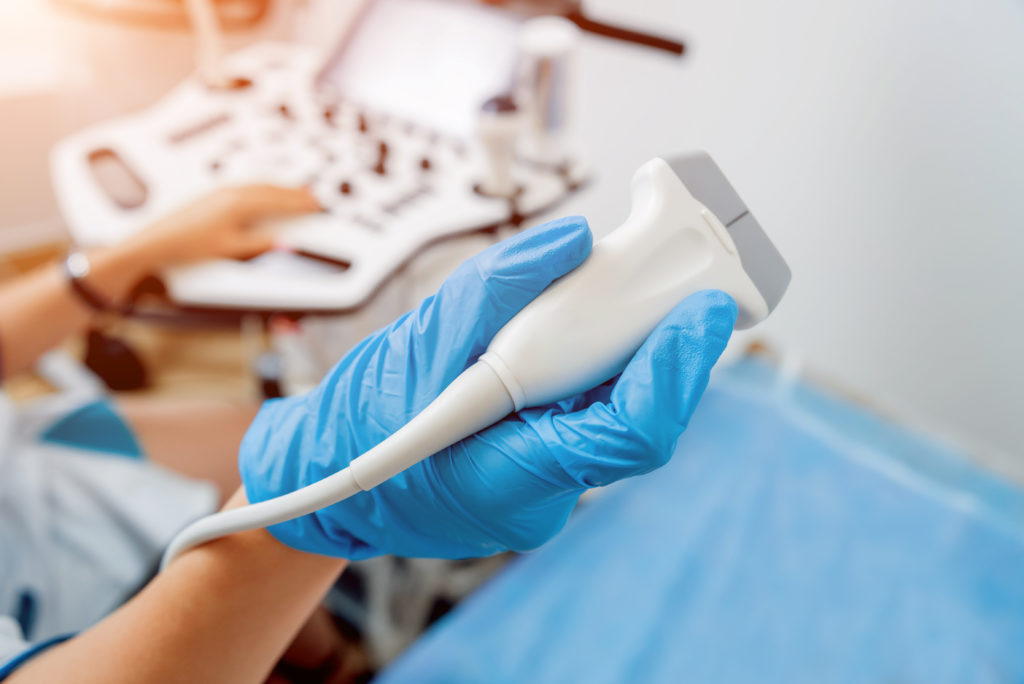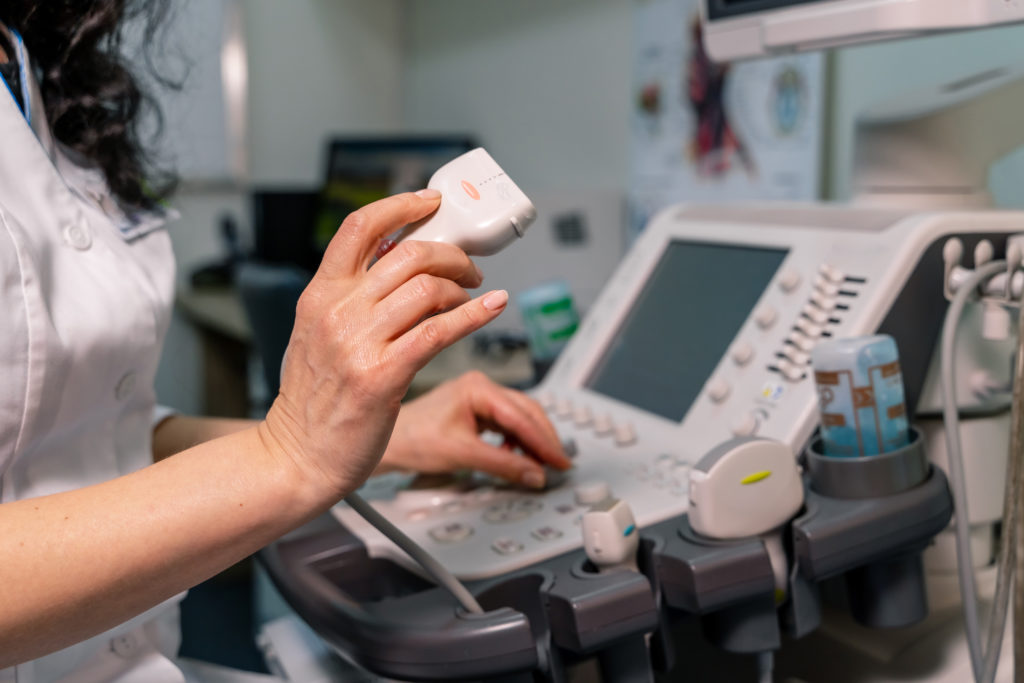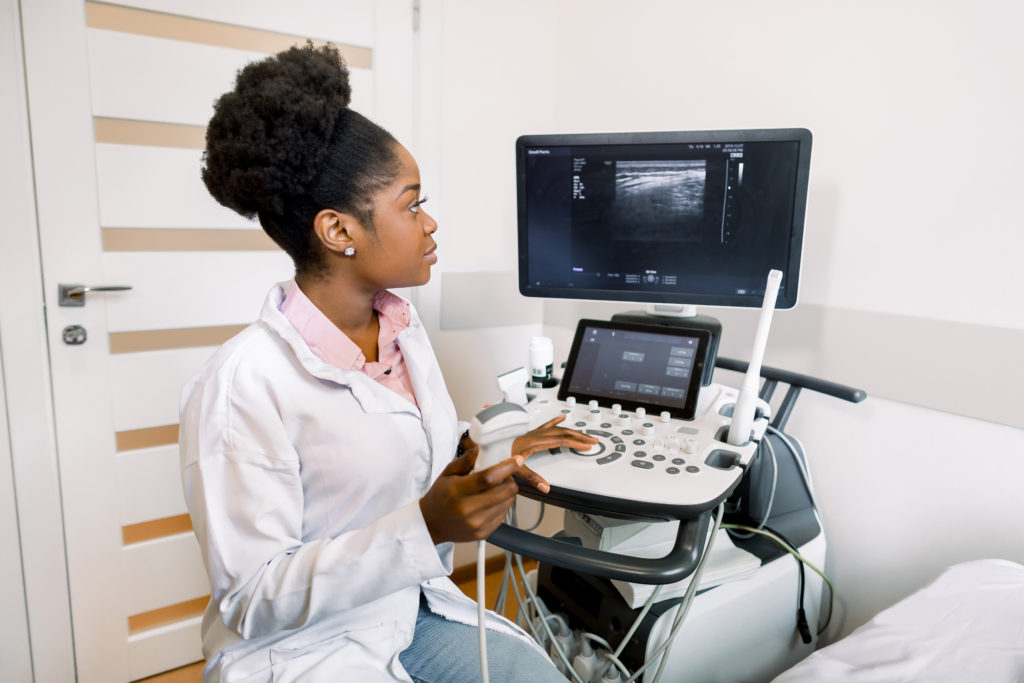
In the healthcare field, different types of equipment and technology are used to create images illustrating what’s going on inside the body. Doctors use these images for a wide range of purposes, from detecting cancer to diagnosing nervous system disorders and from guiding surgeons during operations to monitoring the development of an unborn baby. Operating the machines that create these images requires the work of a trained professional, such as a diagnostic medical sonographer. If you have always had an interest in healthcare and enjoy working with technical machinery, consider a career in sonography by earning a college degree.
The Role of a Diagnostic Medical Sonographer
Like radiologic technologists, sonographers are healthcare professionals with the education and training to perform specific diagnostic medical imaging tests. However, sonographers specialize in using a technology known as sonogram or ultrasound.
Ultrasounds may be best known as a way for obstetricians and expecting parents to peek at the baby growing in the womb. But that’s far from the technology’s only purpose. In fact, diagnostic medical sonographers often specialize in various regions or systems of the body. These specializations include:
- musculoskeletal sonography
- abdominal sonography
- neurosonography
- breast sonography
- gynecologic sonography
- cardiac sonography
Ultrasounds are usually the first diagnostic imaging test a doctor will recommend to confirm or rule out a disease, according to the United States Bureau of Labor Statistics (BLS).
Sonographers interact directly with patients, recording their medical histories and explaining the ultrasound process. They prepare and operate sonogram equipment to create images of the desired region of the body. Doctors then use this to diagnose the condition and develop a treatment plan. Some ultrasounds take place during a surgical procedure and serve as a guide for the surgeon. Sonographers must be able to distinguish between normal and atypical images.
A Sonographer’s Education
If you want to become a sonographer, you must first complete the formal education required. In accredited sonography programs at both the associate’s and bachelor’s degree levels, students take courses dealing with:
- anatomy & physiology
- applied sciences
- medical terminology
Students also gain clinical experience working in:
- hospitals
- laboratories
- doctors’ offices
Often, schools offer programs in particular specializations of sonography, such as:
- abdominal sonography
- breast sonography
- cardiac sonography
- pediatric sonography
- obstetric sonography, and more
These programs serve as preparation for relevant certification exams.
In addition to the required coursework and classroom study found in sonography programs, clinical components are required. Clinical work allows students to work under more experienced sonographers and technologists in:
- imaging laboratories
- hospitals
- medical centers
- physician offices
Graduates of college degree programs in sonography must earn a passing score on a state test to become certified in a given specialty.They may possess more than one certification if they choose to prepare for and take multiple exams. In some states, sonographers must also obtain a license. It is important to remember that most employers seek graduates of programs accredited by the Commission on Accreditation of Allied Health Education Programs (CAAHEP).
If you’re still in high school and considering a career as a sonographer, you should take classes that will help you explore what it would be like in a sonography program. Courses to take in high school that will help prepare you for a sonography program include:
- anatomy
- biology
- chemistry
- math
- physics
- physiology

Qualities Needed for a Career in Sonography
Some qualities and characteristics of successful sonographers are not taught in a traditional classroom. However, these skills can be honed and improved. Below are several important qualities needed to work as a sonographer.
Detail-orientation – Working as a diagnostic imager or sonographer requires the ability to follow specific directions to obtain images that will lead to diagnosing and treating patients. Being detail-oriented helps the technician to detect subtle cues while scanning a patient’s body. Having the ability to detect these cues allows the sonographer to contrast healthy areas with unhealthy ones. Cues may be extremely subtle at times and require a skilled and detail-oriented technician.
Effective communication skills – Since sonographers work closely with patients, strong communication and interpersonal skills are necessary. Imaging workers must convey information to patients who are distressed and in pain. These workers must gain the cooperation of patients during stressful times in order to collect usable images for doctors and specialists. Also, having effective communication skills is necessary for sonographers to convey information to doctors, nurses, and other members of the healthcare team.
Good hand-eye coordination – In order to gather quality images to help diagnose problems and issues, sonographers must have good hand-eye coordination. Job duties of technologists include accurately moving equipment on the patient’s body in response to what they view on screen. Accuracy is critical in gathering useful images that can lead to proper diagnosis and treatment.
Physical stamina – Sonographers work on their feet most days. For long stretches, sonographers must be moving around, lifting patients who require assistance, and being physically active. Having physical stamina makes the job easier, especially during those prolonged periods of physical activity.
Strong technical skills – Sonographers operate complex machinery, computerized instruments, and technology. Having strong technical skills makes a sonographer more effective in obtaining clues used to diagnose and treat problems.
Earnings Potential for Sonographers
The role of a medical sonographer is an important and rewarding one. These specialized healthcare professionals earn a median salary of $59,100 per year, according to the BLS. They also look forward to a highly positive job outlook, with the BLS anticipating a 17% growth in job opportunities over just 10 years. Sonographers also have the satisfaction of knowing that their work helps doctors diagnose and treat patients, potentially improving and saving lives.
Breaking down the earnings by industry and job title, we find some variation. Also, geographic locations do impact earnings potential. According to BLS, the median annual wage for cardiovascular technologists and technicians is $59,100. The highest 10 percent of earners in this occupation made $96,790. Diagnostic medical sonographers earned a median annual wage of $75,920. BLS reports the highest 10 percent of earners in this occupation made over $105,300 per year.
By industry, earnings for both cardiovascular sonographers and diagnostic medical sonographers vary. According to BLS, the four top-paying industries for diagnostic medical sonographers are:
- outpatient care centers
- hospitals
- physician offices
- medical and diagnostic laboratories
The median annual wages for sonographers working in outpatient care centers is $96,780. The second highest-paying industry for sonographers is local, private, and state hospitals. Here, sonographers earn a median annual wage of $76,060. Physician offices pay a median annual wage of $75,270 and sonographers in medical and diagnostic laboratories report $71,650 in earnings.

Geographic location also impacts earnings potential. According to BLS, the top-paying states for diagnostic medical sonographers are:
- California ($108,400 annual mean wage)
- Hawaii ($101,570), Alaska ($95,990)
- District of Columbia ($94,260)
- Rhode Island ($92,460)
Top-paying metropolitan areas for diagnostic medical sonographers include:
- Sacramento, California
- Santa Rosa, California
- Stockton, California
- San Francisco and Oakland, California
- San Jose, California
High-paying nonmetropolitan areas include:
- north valley/northern mountains region of California
- north coast region of California
- northwestern Colorado
- northeastern Wisconsin
- Alaska’s nonmetro areas
Many of these regions offer six figures in annual mean wages.
Sonographers work full-time. Traditional work hours are the norm for sonographers employed by physician offices. In hospitals and labs, some evenings and weekends may be required. Also, in facilities open 24 hours, such as hospitals and medical care centers, overnight work is common.
Job Outlook for Sonographers
According to BLS, employment of sonographers is projected to increase 17% over the next nine years. This growth rate is much faster than the average for all occupations, and it is partly due to the large and aging baby-boom population. This number correlates to approximately 12,500 new jobs being added to current employment for this occupation.
BLS drills down into the job outlook numbers by reviewing different types of sonographers. Diagnostic medical sonographers should see that 17% employment growth as specified above, while cardiovascular technologists and technicians should expect a 5% job growth. Health technologists can anticipate an 8% job growth.
As the baby-boomer population ages, the need to diagnose and treat medical conditions – like blood clots, heart disease, and other issues – will increase. Since imaging technology is used to determine findings and make diagnoses, technologists and sonographers will be needed. The demand for sonographers in hospitals and medical centers will likely increase. Certified personnel and those with the proper education should see the best job prospects. Also, sonographers who have become certified in more than one specialty are expected to find themselves with even greater job prospects.

Job Prospects for Sonographers
There are many different specialties in sonography, and with these specialties come various roles. Below are several different job offerings for diagnostic medical sonographers.
Abdominal sonographer – These highly specialized sonographers focus their attention and expertise on a patient’s abdominal cavity and nearby organs. Abdominal sonographers take images of:
- kidneys
- gallbladders
- livers
- spleens
- other organs
Breast sonographer – Sonographers in this specialty work closely with physicians to take images of breast tissues on patients undergoing tests. Sonography of breast tissues can detect the presence of cysts and tumors after showing up as suspicious findings on mammograms. For breast cancer patients, sonographers may track tumors and help provide information that will assist doctors on the correct treatment plans.
Cardiac sonographer – Cardiac sonographers, also known as echocardiographers, specialize in the imaging of the heart. Specialized ultrasound equipment is used to examine and explore:
- heart chambers
- heart valves
- heart vessels
These specialized tests are performed when a patient is resting and/or active. The cardiac sonographer works closely with physicians and surgeons. During pregnancy, a cardiac sonographer may be involved in assessing fetal hearts so their cardiac conditions may be monitored.
Musculoskeletal sonographer – Specializing in the monitoring of muscles, joints, and ligaments, a musculoskeletal sonographer collects images ordered by physicians that will aid in patient treatment. During surgical procedures, the musculoskeletal sonographer may assist with ultrasound guidance, particularly with injections.
Pediatric sonographer – A pediatric sonographer collects imaging on children and infants. They work closely with pediatricians and other care providers to assist with images associated with birth defects and premature births. Typically, a pediatric sonographer receives a certification in pediatric sonography.
Pulmonary function technologist – These highly trained technologists monitor a patient’s lungs and breathing. They help physicians diagnose and treat problems associated with the pulmonary system. During inhalation and exhalation, pulmonary function technologists collect information by using spirometry to measure air and flow.
Obstetric and gynecologic sonographer – Specializing in the imaging of the female reproductive system, obstetric and gynecologic sonographers perform sonograms on pregnant women. They track a baby’s growth and overall health, working with obstetricians and gynecologists to detect any congenital birth defects.
Vascular technologist – A vascular sonographer or technologist collects images of blood vessels and provides data for physicians that will help diagnose disorders impacting blood flow. Vascular sonographers help identify blood clots and blocked arteries.
Final Thoughts on the Best Degree Path to Becoming a Sonographer
The first step on your degree path to becoming a sonographer is to get the proper education required. Early on in your schooling, gaining a background in math, science, and anatomy helps lay a strong foundation for future requirements. Employers seek graduates of accredited sonography programs, so it is important to research your school and program of interest.
For the best job prospects, programs of interest should be accredited by the Commission on Accreditation of Allied Health Education Programs (CAAHEP).
Related Resources:
- Online Bachelor’s Degree in Health Science: 30 Best
- What Is the Best Degree Path to Becoming a Radiation Therapist?
- 30 Best Online Bachelor’s in Health Sciences and Nutrition
- 5 Healthcare Degrees You Can Earn Online
- 50 Most Affordable Online Degree Programs For In-State Students
